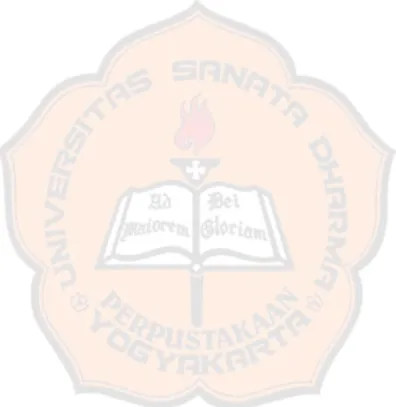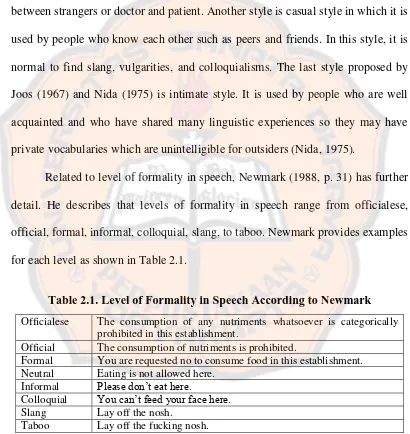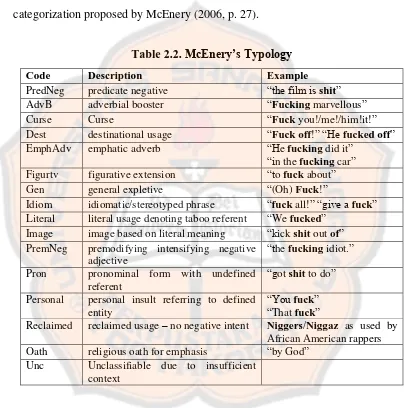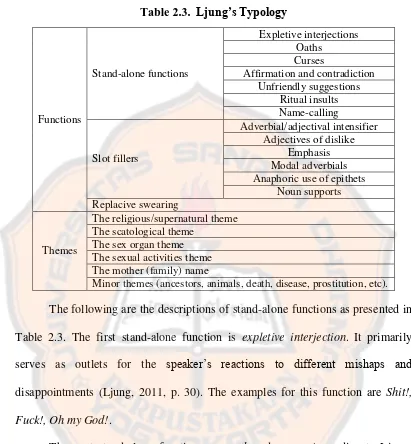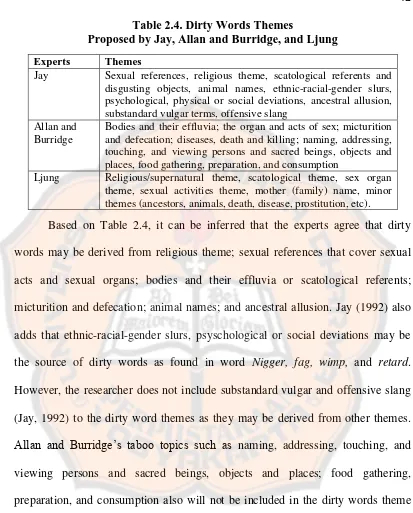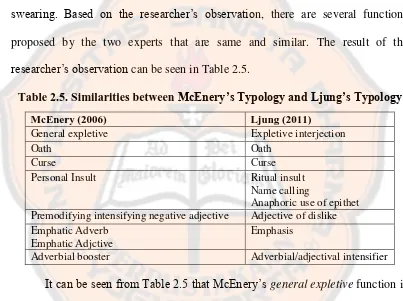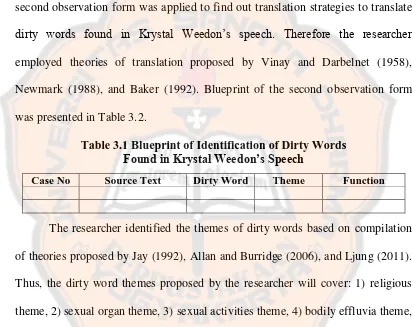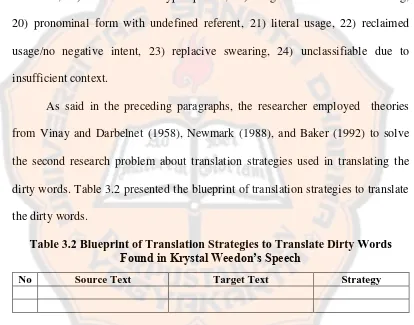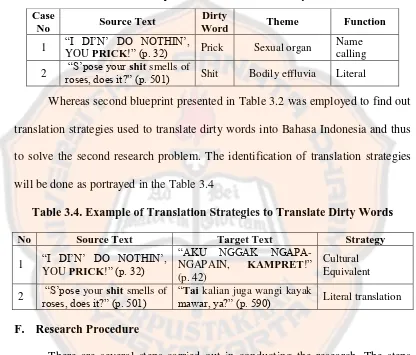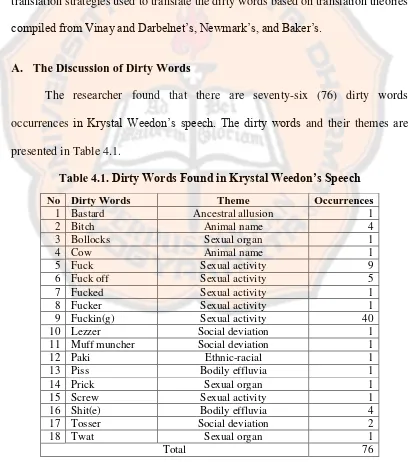vii ABSTRACT
Aprilia, Christina. (2016). Strategies for Translating Krystal Weedon’s Dirty Words in The Casual Vacancy. Yogyakarta: English Language Education Study Program, Department of Language and Arts, Faculty of Teachers Training and Education. Sanata Dharma University.
Translating a dirty word is a tricky matter because sometimes it is too taboo to be translated into another language. In the practice, translators employ various translation strategies to translate dirty words. One example of texts that contains a
lot of dirty words is JK Rowling’s novel entitled The Casual Vacancy. Some characters found in the novel often utter dirty words. One of the characters is Krystal Weedon. Therefore, this research is conducted to find out translation strategies used to translate Krystal Weedon’s dirty words into Bahasa Indonesia.
There were two research problems addressed in the research which were (1)
What are Krystal Weedon’s dirty words in The Casual Vacancy? (2) What are translation strategies that are used to translate Krystal Weedon’s dirty words in The Casual Vacancy?
To answer both research questions, the researcher conducted qualitative research by employing content analysis. The research data were dirty words uttered by Krystal Weedon in The Casual Vacancy and its Indonesian version, Perebutan Kursi Kosong. To answer the first question, the researcher identified the dirty words by using theories proposed by Jay (1992), Allan and Burridge (2006), McEnery (2006), and Ljung (2011). To answer the second research question, the researcher
analyzed the strategies to translate Krystal Weedon’s dirty words by employing
strategies proposed by Vinay and Darbelnet (1958), Newmark (1988), and Baker (1992).
Based on the analyses, the research results show that: 1) there are 18 dirty
words with 76 occurrences found in Krystal Weedon’s speech, 2) based on
compilation of translation strategies employed there are 7 strategies used to
translate dirty words in Krystal Weedon’s speech. Those strategies are borrowing,
literal translation, modulation, functional equivalent, cultural equivalent, compensation, and translation by omission. The researcher also found that there is another strategy employed beyond the proposed ones and therefore is included in other findings.
viii ABSTRAK
Aprilia, Christina. (2016). Strategies for Translating Krystal Weedon’s Dirty Words in The Casual Vacancy. Yogyakarta: Program Studi Pendidikan Bahasa Inggris, Jurusan Pendidikan Bahasa dan Seni, Fakultas Keguruan dan Ilmu Pendidikan. Universitas Sanata Dharma.
Menerjemahkan kata kotor merupakan hal yang cukup sulit sebab seringkali suatu kata kotor terlalu tabu untuk diterjemahkan ke dalam suatu bahasa lain. Dalam prakteknya, para penerjemah menggunakan berbagai macam strategi penerjemahan untuk menerjemahkan kata kotor. Salah satu teks yang memuat banyak kata kotor adalah novel The Casual Vacancy karya JK Rowling. Beberapa karakter yang ada dalam novel tersebut sering mengucapkan kata kotor, salah satunya adalah Krystal Weedon. Oleh karena itu, penelitian ini dilakukan guna menentukan strategi penerjemahan untuk menerjemahkan kata kotor yang diucapkan oleh Krystal Weedon ke dalam Bahasa Indonesia.
Ada dua rumusan masalah yang diajukan dalam penelitian ini yakni (1) Apa saja kata kotor yang diucapkan oleh Krystal Weedon dalam The Casual Vacancy? (2) Apa saja strategi penerjemahan yang digunakan untuk menerjemahkan kata kotor yang diucapkan oleh Krystal Weedon dalam The Casual Vacancy?
Untuk menjawab kedua rumusan masalah, peneliti melakukan penelitian kualitatif dengan analisa konten. Data penelitian berupa kata kotor yang diucapkan oleh Krystal Weedon dalam The Casual Vacancy dan versi bahasa Indonesianya yakni Perebutan Kursi Kosong. Guna menjawab pertanyaan pertama, peneliti mengidentifikasi kata kotor dengan menggunakan teori dari Jay (1992), Allan dan Burridge (2006), McEnery (2006), serta Ljung (2011). Sedangkan untuk menjawab pertanyaan kedua, peneliti menganalisa strategi yang digunakan untuk menerjemahkan kata kotor dalam ucapan Krystal Weedon dengan menggunakan strategi penerjemahan yang diajukan oleh Vinay dan Darbelnet (1958), Newmark (1988), serta Baker (1992).
Berdasarkan analisa, hasil dari penelitian ini menunjukkan bahwa: 1) ada 18 macam kata kotor yang ditemukan dalam ucapan Krystal Weedon dengan kemunculan sebanyak 76 kali, 2) berdasarkan gabungan strategi penerjemahan yang digunakan, ada 7 strategi yang digunakan untuk menerjemahkan kata kotor dalam ucapan Krystal Weedon. Strategi tersebut adalah borrowing, literal translation, modulation, functional equivalent, cultural equivalent, compensation, dan translation by omission. Peneliti juga menemukan bahwa selain gabungan strategi penerjemahan yang diajukan oleh para ahli, ada strategi lain yang digunakan oleh penerjemah dan oleh karenanya peneliti memasukkannya ke dalam hasil temuan yang lain.
STRATEGIES FOR TRANSLATING KRYSTAL WEEDON
’S
DIRTY WORDS IN THE CASUAL VACANCY
A SARJANA PENDIDIKAN THESIS
Presented as Partial Fulfillment of the Requirements to Obtain the Sarjana Pendidikan Degree
in English Language Education
By Christina Aprilia Student Number: 091214099
ENGLISH LANGUAGE EDUCATION STUDY PROGRAM DEPARTMENT OF LANGUAGE AND ART EDUCATION FACULTY OF TEACHERS TRAINING AND EDUCATION
SANATA DHARMA UNIVERSITY YOGYAKARTA
i
STRATEGIES FOR TRANSLATING KRYSTAL WEEDON
’S
DIRTY WORDS IN THE CASUAL VACANCY
A SARJANA PENDIDIKAN THESIS
Presented as Partial Fulfillment of the Requirements to Obtain the Sarjana Pendidikan Degree
in English Language Education
By Christina Aprilia Student Number: 091214099
ENGLISH LANGUAGE EDUCATION STUDY PROGRAM DEPARTMENT OF LANGUAGE AND ART EDUCATION FACULTY OF TEACHERS TRAINING AND EDUCATION
SANATA DHARMA UNIVERSITY YOGYAKARTA
iv
“
I can do all things through Christ who strengthens me.
”
(Philippians 4:13)
“
Every step makes a difference.
Then, look around and watch your step.
Don’t stop, go your way.
”
“
Choice was dangerous:you had to forgot all other possibilities when you chose.”
(J.K. Rowling - The Casual Vacancy)
This thesis is dedicated to those who always
shower me with endless love, believe in me,
vii ABSTRACT
Aprilia, Christina. (2016). Strategies for Translating Krystal Weedon’s Dirty Words in The Casual Vacancy. Yogyakarta: English Language Education Study Program, Department of Language and Arts, Faculty of Teachers Training and Education. Sanata Dharma University.
Translating a dirty word is a tricky matter because sometimes it is too taboo to be translated into another language. In the practice, translators employ various translation strategies to translate dirty words. One example of texts that contains a lot of dirty words is JK Rowling’s novel entitled The Casual Vacancy. Some characters found in the novel often utter dirty words. One of the characters is Krystal Weedon. Therefore, this research is conducted to find out translation strategies used to translate Krystal Weedon’s dirty words into Bahasa Indonesia.
There were two research problems addressed in the research which were (1) What are Krystal Weedon’s dirty words in The Casual Vacancy? (2) What are translation strategies that are used to translate Krystal Weedon’s dirty words in The Casual Vacancy?
To answer both research questions, the researcher conducted qualitative research by employing content analysis. The research data were dirty words uttered by Krystal Weedon in The Casual Vacancy and its Indonesian version, Perebutan Kursi Kosong. To answer the first question, the researcher identified the dirty words by using theories proposed by Jay (1992), Allan and Burridge (2006), McEnery (2006), and Ljung (2011). To answer the second research question, the researcher analyzed the strategies to translate Krystal Weedon’s dirty words by employing strategies proposed by Vinay and Darbelnet (1958), Newmark (1988), and Baker (1992).
Based on the analyses, the research results show that: 1) there are 18 dirty words with 76 occurrences found in Krystal Weedon’s speech, 2) based on compilation of translation strategies employed there are 7 strategies used to translate dirty words in Krystal Weedon’s speech. Those strategies are borrowing, literal translation, modulation, functional equivalent, cultural equivalent, compensation, and translation by omission. The researcher also found that there is another strategy employed beyond the proposed ones and therefore is included in other findings.
viii ABSTRAK
Aprilia, Christina. (2016). Strategies for Translating Krystal Weedon’s Dirty Words in The Casual Vacancy. Yogyakarta: Program Studi Pendidikan Bahasa Inggris, Jurusan Pendidikan Bahasa dan Seni, Fakultas Keguruan dan Ilmu Pendidikan. Universitas Sanata Dharma.
Menerjemahkan kata kotor merupakan hal yang cukup sulit sebab seringkali suatu kata kotor terlalu tabu untuk diterjemahkan ke dalam suatu bahasa lain. Dalam prakteknya, para penerjemah menggunakan berbagai macam strategi penerjemahan untuk menerjemahkan kata kotor. Salah satu teks yang memuat banyak kata kotor adalah novel The Casual Vacancy karya JK Rowling. Beberapa karakter yang ada dalam novel tersebut sering mengucapkan kata kotor, salah satunya adalah Krystal Weedon. Oleh karena itu, penelitian ini dilakukan guna menentukan strategi penerjemahan untuk menerjemahkan kata kotor yang diucapkan oleh Krystal Weedon ke dalam Bahasa Indonesia.
Ada dua rumusan masalah yang diajukan dalam penelitian ini yakni (1) Apa saja kata kotor yang diucapkan oleh Krystal Weedon dalam The Casual Vacancy? (2) Apa saja strategi penerjemahan yang digunakan untuk menerjemahkan kata kotor yang diucapkan oleh Krystal Weedon dalam The Casual Vacancy?
Untuk menjawab kedua rumusan masalah, peneliti melakukan penelitian kualitatif dengan analisa konten. Data penelitian berupa kata kotor yang diucapkan oleh Krystal Weedon dalam The Casual Vacancy dan versi bahasa Indonesianya yakni Perebutan Kursi Kosong. Guna menjawab pertanyaan pertama, peneliti mengidentifikasi kata kotor dengan menggunakan teori dari Jay (1992), Allan dan Burridge (2006), McEnery (2006), serta Ljung (2011). Sedangkan untuk menjawab pertanyaan kedua, peneliti menganalisa strategi yang digunakan untuk menerjemahkan kata kotor dalam ucapan Krystal Weedon dengan menggunakan strategi penerjemahan yang diajukan oleh Vinay dan Darbelnet (1958), Newmark (1988), serta Baker (1992).
Berdasarkan analisa, hasil dari penelitian ini menunjukkan bahwa: 1) ada 18 macam kata kotor yang ditemukan dalam ucapan Krystal Weedon dengan kemunculan sebanyak 76 kali, 2) berdasarkan gabungan strategi penerjemahan yang digunakan, ada 7 strategi yang digunakan untuk menerjemahkan kata kotor dalam ucapan Krystal Weedon. Strategi tersebut adalah borrowing, literal translation, modulation, functional equivalent, cultural equivalent, compensation, dan translation by omission. Peneliti juga menemukan bahwa selain gabungan strategi penerjemahan yang diajukan oleh para ahli, ada strategi lain yang digunakan oleh penerjemah dan oleh karenanya peneliti memasukkannya ke dalam hasil temuan yang lain.
ix
ACKNOWLEDGEMENTS
I thank Jesus Christ and Mother Mary for always guiding me in living my life. I’m so grateful to have them leading my life and showering me with endless blessings.
I thank Ibu Carla Sih Prabandari, S.Pd., M.Hum., who has become my thesis advisor. I thank her for the feedback, comments, and advice so that I can improve my thesis. I also thank her as my academic advisor for her time, patience, guidance, support and encouragement during my college life, especially the time when I struggle to finish this thesis.
I thank Drs. Barli Bram, M.Ed., Ph.D. for the advice, comments, suggestions and corrections. Those motivate me to write the thesis better.
I thank Bapak Paulus Kuswandono, Ph.D as the chairperson of PBI, and all PBI lecturers who have taught and educated me during college life. I thank all PBI staff especially Mbak Danik, who helps me to deal with administration stuffs. I also thank the staff of Sanata Dharma library.
My special thanks are dedicated to Bapak Yulius Mugi Karyono, Ibu Maria Sri Hartatik, Mas Yohanes Dema Sri Oktafiyan, and Simbah Yustina Harjowiyono. As my family, they have given me endless love, raised me well and supported me. Their love and prayers always strengthen me.
x
finishing thesis; the struggle is real and we keep fighting for it till the finish line. I also thank Momon, Dika, Odhile, Mbak Ayu Ganjar, and Cinta, who always support me in finishing my thesis. My sincere gratitude also goes to my friends in Elegy, PPL Depsa ‘12, Golden Lantern, KKN XLV (Jetsuers), OMK, PIA, Paguyuban Lektor Gamping and all my private students. I always enjoy the process and cherish every moment I have.
I also address my gratitude to CNBLUE for producing great music that I listen to since years ago. “다죽자!!!”
Finally, I thank everyone who knows me and cares about me. Forgive me for not mentioning you one by one. I pray the best for you and I believe that God surely knows your good deeds for me. May his blessing be with you.
xii
b. Language Variation in Speech ... c. Level of Formality in Speech ... d. Dirty Words ...
xiii
CHAPTER V. CONCLUSION AND RECOMMENDATIONS
A. Conclusions ... B. Recommendations ... REFERENCES ... APPENDICES ...
xiv
LIST OF TABLES
Table 2.1. Level of Formality in Speech According to Newmark ... 12
Table 2.2. McEnery’s Typology ...23
Table 2.3. Ljung’s Typology ... Table 2.4. Dirty Words Themes Proposed by Jay, Allan and Burridge, and Ljung ... Table 2.5. Similarities between McEnery’s Typology and Ljung’s Typology ... 24 42 43 Table 3.1 Blueprint of Identification of Dirty Words Found in Krystal Weedon’s Speech ...49
Table 3.2 Blueprint of Translation Strategies to Translate Dirty Words Found in Krystal Weedon’s Speech ...50
Table 3.3. Example of Identification of Dirty Words ...53
Table 3.4. Example of Translation Strategies to Translate Dirty Words ...53
Table 4.1. Dirty Words Found in Krystal Weedon’s Speech ...56
Table 4.2. The Occurrences of Translation Strategies ...79
Table 4.3. Examples of Omission Strategy ...80
Table 4.4. Examples of Cultural Equivalent Strategy ...81
Table 4.5. Examples of Functional Equivalent Strategy ...85
Table 4.6. Examples of Modulation Strategy...86
Table 4.7. Examples of Compensation Strategy ...87
xv
1
CHAPTER I INTRODUCTION
This chapter serves as an introduction to the research. It is divided into six parts. This intends for aiding the readers in understanding the research taken, namely research background, research problem, problem limitation, research objectives, research benefits, and definition of terms.
A. Research Background
Dirty words are commonly found in daily life. It can be said that all languages have dirty words. However, to define dirty words is quite tricky. Dirty words may cover swear words, curse words, four-letter words, epithets, obscenities, profanity, taboo language, slang terms etc. Even though these words can be heard in daily conversation, scenes in a movie, and even written in novel, the study of dirty words is rarely done in school since they are ‘dirty’, related to
vulgar and taboo thing. As an effect, students knows the dirty words from outside the school and sometimes use them without knowing the meanings and when to use them. Based on this fact, the research of dirty words and the translations of them is important to be done. The research of dirty words and the translations is needed to help the students understand dirty words further such as what belong to dirty words, the meaning of them, and their usages in a context.
by J. K. Rowling. The novel itself was published worldwide by the Little, Brown Book Group in September 2012. In November 2012, the novel was translated into Bahasa Indonesia as Perebutan Kursi Kosong by three translators and was published by Penerbit Qanita. The novel, which has been adapted on-screen as three-episode miniseries aired in the United Kingdom (February-March 2015) and in the United States (April-May 2015), tells the readers about the conflicts and problems faced by the citizens after the death of Barry Fairbrother, a Parish Councillor in a fictive town called Pagford. The death causes a vacancy in a seat on the council and arises conflict before the election for his successor takes place. Beside political theme, The Casual Vacancy covers a range of social issues such as rape, drug use, domestic abuse, racism, and suicide as noted by Losowsky in his article entitled “The Casual Vacancy's Review: JK Rowling's Long-Awaited New Book” published by Huffington Post on September 26th, 2012.
This research, thus, is going to focus on a dirty words found in character’s
speech and the translation of the dirty words. The researcher chooses to focus to a character’s speech as it is one of the ways to characterize character. Murphy
(1972) says that through speech, the author can give the readers an insight about the character (p. 164). It is also a key element of character development. If it is done right, it can impact a strong sense of realism about the character. Thus, by reading the characters’ speech, the readers are expected to know who and how the
characters are. Further, speech or language spoken in a novel has same function like found in real life which is a means of communication for people to interact with other. Sapir (1956, p.69), as quoted by Bassnett (2002, p. 21), states that language is a guide to social reality and it becomes the medium for human being to express and to communicate in the society. Thus, through speech each character expresses their thought and communicates with other characters. By employing speech in which dirty words are found, the researcher expects to understand the use of the dirty words in the context.
habits and language. She is also described developing personal relationship with Stuart ‘Fats’ Wall. With the portrayal mentioned above, thus, it is interesting to
discuss dirty words found in Krystal Weedon’s speech.
The translation of the dirty words is also going to be discussed. Translation is defined as an attempt to replace a written message and/or statement in one language by the same message and/or statement in another (Newmark, 1988, p. 7). Lefevere (1992, p. 17) describes since language is also the expression and the repository of a culture, many of the words in a language are inextricably bound up with that culture and therefore very hard to transfer in their totality to another language. Thus, Nida and Taber (1982, p. 12) suggest that the translators must be familiar with both languages in order to find out the closest natural equivalent of source language (SL) message and reproduce it in target language (TL). Nababan (1999, p. 26) states that there are two important factors in translation. Those are linguistic factors that cover words, phrases, clauses and sentences, and non-linguistics factors that cover the cultural knowledge on both source and target language culture. In this research, the translation of dirty words are those that will be discussed. Lefevere (1992, p. 58) notes that in different cultures a specific use of language is considered appropriate (or inappropriate) in a specific situation. Thus, it is interesting to see how the translators play their roles to “render the meaning of the text into other languages in the way that the
of the source text will not be heightened by a mere literal translation of the words on the page in what amounts to a cultural vacuum.”
By conducting this research, the researcher expects that the findings of this research will be beneficial for both practical and academical fields. Since this research focuses on dirty words and translation, the findings may be beneficial for Sociolinguistics and Translation course in English Language Education Study Program (ELESP). In relation to the Sociolinguistics course, this research will provide material related to language variation and level of formality in speech which uses dirty words. The discussions of themes and functions of the dirty words based on the context are expected to give ELESP students some examples about the dirty words usage in the utterances. While in relation to the Translation course, this research is expected to give contribution on how to take dirty words using translation strategies and what considerations need to take in the process.
B. Research Problems
Based on the research background, the problems of this research are formulated as follow:
1. What are Krystal Weedon’s dirty words in The Casual Vacancy?
C. Problem Limitation
This research focuses on the speech of Krystal Weedon, a character found in The Casual Vacancy. To be more specific, it deals with dirty words uttered when Krystal speaks with her interlocutors. The researcher develops the research to find out the translation strategies used by the translators to translate dirty words found in Krystal’s speech. This research employed translation strategies proposed
by Vinay and Darbelnet (1958), Newmark (1988), and Baker (1992) to analyze the manner in which the translators translate Krystal Weedon’s dirty words.
D. Research Objectives
The objectives of this research are:
1. To find out Krystal Weedon’s dirty words in The Casual Vacancy.
2. To find out translation strategies employed by the translators to translate Krystal Weedon’s dirty words.
E. Research Benefits
This research is expected to have contribution for: 1. English Teachers
English teachers would know better about dirty words so they could explain dirty words to their students properly. Further, the teacher would also know how translation strategies play roles in translating a character’s speech.
2. Students
are expected to know the situation in which they can utter the dirty words. Through this research, the students would also learn how translation strategies play roles in translating the dirty words into Bahasa Indonesia.
3. Translators
The research findings will give translators, especially who work for English-Bahasa Indonesia translation, more considerations in taking appropriate translation strategies to translate dirty words.
4. For Further Research
This research will contribute to translation of literary work, specifically the translation of dirty words. The research can be used or referred for further researches especially those which deal with translation of dirty words.
F. Definition of Terms
In this part, the researcher is going to give some definitions of terms used in this research. The terms which are going to be described are strategies in translating, dirty words, and Krystal Weedon of The Casual Vacancy.
1. Strategies for Translating
2. Dirty Words
Dirty words are words that may cause offence. These words have different labels given by scholars and experts. Jay (1992) calls them as offensive words, and taboo words; Allan and Burridge (2006) call them as forbidden words; while Fägersten (2012) calls them as swear words. Therefore, in this research what belong to dirty words are those that are considered offensive, insulted, and forbidden to be said in formal condition like meeting or casual conversation. 3. The Casual Vacancy
The Casual Vacancy is an adult novel written by J.K. Rowling. It tells the readers about the conflicts and problems faced by the citizens after the death of Barry Fairbrother, a Parish Councillor. It was published worldwide by the Little, Brown Book Group in September 2012. In this research, The Casual Vacancy acts as research source, in which the researcher took the data from to answer the first formulated problem about dirty words. It also acts as Source Text in relation to second formulated problem about translation strategies to translate dirty words. 4. Perebutan Kursi Kosong
9 CHAPTER II
REVIEW OF LITERATURE
The contents of this chapter are to explain the theories related to the conduct of this research. This chapter consists of two parts, namely theoretical description and theoretical framework. The theoretical description presents the theories of speech and theories of translation. The theoretical framework provides theories to solve the research problems.
A. Theoretical Description
This section discusses two major parts of theoretical description, namely theories of speech and theories of translation. The theories are used to enhance the researcher’s knowledge about the topic discussed and solve the research problems.
1. Theories of Speech
In this part, the researcher discusses the theories of speech as the research is dealing with speech, especially dirty words uttered in the speech. Therefore, the theories cover speech in a novel, language variation in speech, level of formality in speech, and dirty words in English.
a. Speech in a Novel
The author’s relationship to his characters is god-like (Harvey, 1965, p.
dispositional qualities that are expressed in what they say—the dialogue—and what they do—the action (Abrams, 1981, p. 23)”. To create character, the author goes through a process named characterization. Characterization is how the author describes the character in a work. According to Murphy (1972), there are nine ways in which an author attempts to make his characters understandable to and come alive for his readers. Those are personal description, characters as seen by another, speech, past life, conversation of others, reactions, direct comment, thoughts, and mannerism. As this research only focuses on the language spoken by a character, thus only speech will be discussed further.
Speech is important to characterize a character. Through what the character says, the author can give the readers an insight about the character (Murphy, 1972, p. 164). Whenever the character speaks, whenever he is in conversation with another, whenever he puts forward an opinion, he is giving us some clues to his character. Further, speech which tries to imitate everyday spontaneous speech will “serve to advance the plot, and in certain writers [...] will carry a large share of
this function, its more customary role is to contribute to the presentation and development of character (Page, 1973, p. 14). Therefore, speech also has important role in building the story.
b. Language Variation in Speech
Language variation or language variety is “a sub-set of formal and/or
English is usually used in the printed media (newspapers and books), associated with education, and used in the broadcasting world and other public contexts. Instead of the spoken language, it is more easily described in terms of the written language (vocabulary, spelling and grammar). In the other hand, non-standard English is related to people who have low statuses in society. Therefore, it is usually labeled as “bad” or “vulgar” language while standard English is often
labeled as “good” English.
Hatim and Mason (1990) explain that there are two dimensions recognized which contribute to language variation. Those are user-related varieties and use-related varieties. The earlier deals with the user in a particular language event: who the speaker is. It differs from person to person primarily in the phonic medium. The latter is related to the use to which a user puts language. Use-related varieties differ from each other primarily in language form (e.g. grammar and lexis). Since it has relation with an individual’s background, author can employ l anguage variation to assert the characters in his novel through their speeches.
c. Level of Formality in Speech
public auditorium. It is used for most academic and scientific publishing. Whereas consultative style according to Joos (1967) is a standard form of communication. Nida (1975) adds that consultative style occurs between people who do not know each other and talk about something neutral. It can be found in conversation between strangers or doctor and patient. Another style is casual style in which it is used by people who know each other such as peers and friends. In this style, it is normal to find slang, vulgarities, and colloquialisms. The last style proposed by Joos (1967) and Nida (1975) is intimate style. It is used by people who are well acquainted and who have shared many linguistic experiences so they may have private vocabularies which are unintelligible for outsiders (Nida, 1975).
Related to level of formality in speech, Newmark (1988, p. 31) has further detail. He describes that levels of formality in speech range from officialese, official, formal, informal, colloquial, slang, to taboo. Newmark provides examples for each level as shown in Table 2.1.
Table 2.1. Level of Formality in Speech According to Newmark Officialese The consumption of any nutriments whatsoever is categorically
prohibited in this establishment.
Official The consumption of nutriments is prohibited.
Formal You are requested no to consume food in this establishment.
Neutral Eating is not allowed here.
Informal Please don’t eat here.
Colloquial You can’t feed your face here.
Slang Lay off the nosh.
Taboo Lay off the fucking nosh.
officialese style and slang style. Officialese style employs scientific terms such as nutriments referring to food while slang style employs nosh, a slang term for food. From the Table 2.1, it can also be seen that both slang and taboo style have similiar pattern but the addition of word fucking in the sentence makes slang style changes into taboo style as fucking is offensive and categorized as taboo word.
d. Dirty Words
Terminology dirty word is quite tricky since there are many different labels proposed by scholars and experts. Expert such as Jay (1992, p. 1) uses the term cursing in his Cursing in America to refer to “all sorts of dirty word usage” though he knows that it might be “somewhat inexact.” Then later in his other
What language and words are perceived as dirty, foul or bawdy in a culture having connection with what is considered taboo in the culture itself. Like taboos, the condemnation of some words as dirty and inappropriate is a social construct. Thus, the concept of taboo is necessary to discuss. According to Allan and Burridge (2006, p. 1) there are several topics of taboos including bodies and their effluvia; the organs and acts of sex, micturition and defecation; diseases, death and killing; naming, addressing, touching and viewing persons and sacred beings, objects and places; food gathering, preparation and consumption They consider that some taboos are specific for a certain culture, but many are almost universal.
Those taboo topics construct dirty words and people use dirty words for many different purposes. Jay (1992, p. 2-9) divides them into ten categories which are cursing, profanity, blasphemy, taboo, obscenity, vulgarity, slang, epithets, insults and slurs, and scatology.
Jay also interprets religious taboos in his profanity and blasphemy category. There is an assumption that profanity and blasphemy mean the same thing but if one examine the intent of each speech form, he will see that they are different. According to Jay (1992, 3) profanity is related to the secular or indifferent (to religion). Thus, to be profane means to be secular or behaving outside the customs of religious belief and to be ignorant or intolerant of the guidelines of a particular religious order. An example of profanity would be a word or phrase which seeks not to denigrate God, religion or holy affairs but would be based more on ignorance of or indifference to these matters. The examples are like “Jesus Christ, I’m hungry!” and “For the love of Christ, get off
the phone!” Whereas, blasphemy aims directly at the church and obtains scorn via the power of the church. Therefore, blasphemy would appear as a direct attack on religious figures re religious authority. The examples of blasphemy are “Screw the
Pope!” and “Shit on what it says in the Bible!” However, most theories do not make distinction between these two.
some animal names (bitch, pig, ass); ethnic-racial-gender slurs (nigger, fag, dago); insulting references to perceived psychological, physical, or social deviations (retard, wimp, lard ass); ancestral allusions (son of a bitch, bastard); substandard vulgar terms (fart face, on the rag); and offensive slang (cluster fuck, tit run). Jay (1992, p. 10-15) explains that taboo words are used for their emotional impact on people rather than for their literal or denotative interpretation. In messages, taboo words are more likely to be interpreted connotatively by listeners, rather than denotatively. For example, most listeners would interpret the utterance “My job is fucked up” as there was something wrong
with the work.
The next category is obscenity. According to Jay (1992, p. 5), the definition of obscenity is not fixed but dynamic because the law changes or evolves over time in response to changes in society and the courts’ decision.
Another expert, Henderson (1991, p. 2) defines obscenity as “verbal reference to areas of human activity or parts of the human body that are protected by certain taboos agreed upon by prevailing social custom and subject to emotional aversion or inhibition”. Thus, in Henderson’s view obscenity is related to sexual and excremental areas.
Obscene words are considered the most offensive and are rarely used in public media. The examples are fuck, motherfucker, cocksucker, cunt, or tits that have gained universal restriction. The obscene word “fuck” although restricted in
media is one of the most frequently recorded dirty words in public, especially in the form of an expletive.
The category of vulgarity in Jay’s view is rather general. In his opinion, vulgarity means the language of the common person, “the person in the street”, or the unsophisticated, unsocialized, or under-educated so that it do not necessarily have to be obscene or taboo but just reflect the crudeness of street language. Words such as snot, slut, crap, kiss my ass, puke are not really offensive but maybe considered impolite or inappropriate.
Another category proposed by Jay is slang. According Jay (1992, p. 6), slang is a vocabulary that is developed in certain sub-groups (teenagers, musicians, soldiers, drug users, or athletes) for ease of communication. Swan (1996, p. 22) defines slang as a word, expressions or special use of language found mainly in very informal speech, especially in the usage of particular groups of people. Thus, slang code serves to identify members of the group, while misuse or ignorance of it identifies non-members, which may be especially important in illegal transactions (Jay, idem).
dialect words, jargon, profanity and obscenity, colloquialism, and cant or argot although slang shares some characteristics with each of these and can overlap them. Akmaijan et al (idem) state that there are some salient features of slang which are 1) being part of casual, informal style of language use so that it has traditionally carried a negative connotation and it is often perceived as a “low” or
“vulgar” form of language, 2) being rapidly changing—slang terms enter a language rapidly but after a few years or even months they fall out of fashion, 3) being associated with a particular social group so that one can speak teenage slang, prison slang, and so on. Dumas and Lighter (1978, p. 14-16) propose four identifying criteria for slang which are 1) the presence of slang will markedly lower the dignity of formal or serious speech or writing, 2) the use of slang implies the user’s special familiarity either with the referent or with that less
statusful or less responsible class of people who have such special familiarity and use the term, 3) being a tabooed term in ordinary discourse with persons of higher social status or greater responsibility, 4) being used in place of the well-known conventional synonym, especially in order (a) to protect the user from the discomfort caused by the conventional item or (b) to protect the user from the discomfort or annoyance of further elaboration. Although slang is not really a category of dirty words, the two often go hand in hand. The reason is they both are features of substandard language and people are like to use them in the same context as explained above.
entirely new words such as barf, flub, and pooped. Jay (1992, p. 7) notes that sometimes slang terms become popular and are used in standard language so that sub-group members have to invent a new code. However, other terms are never integrated into standard dialects due to their offensiveness to public. The examples of slang terms are pimp, cherry, john.
The next category is epithet. Jay (1992, p. 7) notes that epithets are brief but forceful bursts of emotional language. The term epithet itself can be misleading since in syntax the term epithet is used for adjective or phrases describing a characteristics of a person or thing. Other theorists usually call it as swearing. Ljung (2011, p. 4) proposes criteria for what constitute swearing or in Jay’s term epithet as the following:
1. Swearing is the use of utterances containing taboo words 2. The taboo words are used with non-literal meaning
3. Many utterances that constitute swearing are subject to severe lexical, phrasal and syntactic constraints which suggest that most swearing qualifies as formulaic language
4. Swearing is emotive language: its main function is to reflect, or seem to reflect, the speaker’s feelings and attitudes.
Thus, it can be concluded that epithet or swearing is using taboo word in an utterance without referring to its literal meaning to express the speaker’s
emotions toward the incidents. It is in line with Jay’s arguments (1992, p. 7) that epithet is yelled at a selected wrongdoer or a person who does something stupid or frustrating (in case of a man crowds the check-out line) and is uttered serving no corrective purpose (as with the targeted use) but mainly serving to reduce the anger level of the speaker (in case of hitting self with a hammer). The examples of epithet as noted by Jay are shit, damn, hell, son of a bitch, goddamn it, fuck you, fuck off, piss off, Jesus Christ.
The last category proposed by Jay is scatology and it is more semantic than pragmatic. According to Jay (1992, p. 9) scatology is the study of excrement; interest in or the treatment of obscene matters. Thus, scatological terms refer to human waste products and processes. Since scatological references are about feces and elimination they appear as poop, turd, crap, shit, piss, piss off, fart. Some people say that only the vulgar would use scatological terms, when a more refined euphemism or technical term could be substituted.
In order to be able to preserve the function of the dirty word and the exact meaning of the word, the first distinction made is to decide whether the dirty words are used denotatively or figuratively. Denotative or literal meaning is the actual meaning of a word. For example in a sentence like He is fucking her, the word fuck is used denotatively meaning a sexual act and thus is essential to the understanding of the sentence. Whereas in a sentence like He is fucking crazy, the word fuck is used for emphasizing the word stupid so that can be left out without harming the understanding of the sentence. In the translation, dirty word used literally cannot be omitted but may be replaced by a less offensive dirty word. If the target language lacks an equivalent dirty word, it is possible that the translator employs a neutral word to express the denotative meaning.
In contrast to literal use, dirty words can be used figuratively. Presented in Jay’s categories, it can be seen that words such as bitch in an insult, fuck you in a
Based on the scheme given, dirty words, or in McEnery’s context known as bad language can serve for different labels. Therefore, McEnery proposes a typology of bad language words based on functional term. Table 2.1 shows the categorization proposed by McEnery (2006, p. 27).
Table 2.2. McEnery’s Typology
Code Description Example
PredNeg predicate negative “the film is shit”
AdvB adverbial booster “Fucking marvellous”
Curse Curse “Fuck you!/me!/him!it!”
Dest destinational usage “Fuck off!” “He fucked off”
EmphAdv emphatic adverb “He fucking did it”
“in the fucking car”
Figurtv figurative extension “to fuck about”
Gen general expletive “(Oh) Fuck!”
Idiom idiomatic/stereotyped phrase “fuck all!” “give a fuck”
Literal literal usage denoting taboo referent “We fucked”
Image image based on literal meaning “kick shit out of”
PremNeg premodifying intensifying negative adjective
“the fucking idiot.”
Pron pronominal form with undefined
referent
“got shit to do”
Personal personal insult referring to defined entity
“You fuck”
“That fuck”
Reclaimed reclaimed usage – no negative intent Niggers/Niggaz as used by African American rappers
Oath religious oath for emphasis “by God”
Unc Unclassifiable due to insufficient
context
for the word (you). Word fuck in phrasal verb fuck off belongs to Dest category, not only the intention to some degree is to insult but also a demand being made that the target go away. The word fuck belongs to Gen utterance is used as an expression of general anger, annoyance or frustration. While in the case of Literal category, the word fuck does not have intention to insult, merely an intent to describe an act of coitus.
However Ljung (2011: 28), who focuses on study of swearing, notes that some examples such as the utterance Kick the shit out of someone may fall into Image and Idiom category in McEnery’s typology. This is caused by basing the categories on grammatical, pragmatic and/or semantic criteria. Therefore, he presents another typology. His categorization scheme features a distinction between functions and themes, where “the functions are the uses that the swearing
constructions are put to by the swearers, while the themes are the different taboo areas that these constructions draw on” (Ljung, 2011, p. 29). Ljung’s typology is presented in Table 2.3.
Table 2.3. Ljung’s Typology
Minor themes (ancestors, animals, death, disease, prostitution, etc).
inflict harm or punishment on someone or something”. In the past, curses have
religious reference as in May the devil take you! but today, curses more often occur in abbreviated forms and often based on other themes, as in Fuck you!, I’ll be damned! (ibid., 2011, p. 31-32). Both oath and curse have been proposed in McEnery’s typology (2006) presented in Table 2.2. In the preceding paragraphs, it
can also be seen that Jay (1992) has already discussed curse as one of his categories of dirty words.
The next stand-alone function is affirmation and contradiction. Ljung (2011, p. 32) notes certain swearing expression may express contradiction and affirmation of the preceding utterance. However, contradiction is far more common than affirmation like reply of utterance “The lock is broken.” may take forms in “Fuck/Bugger/The hell it is.”
Another stand-alone function is unfriendly suggestion. Ljung (2011, p 32) argues that it is used to express aggression directed at somebody and are often used in dialogue to indicate the speaker’s reaction to what is said. The examples
include Fuck off!, Go to hell!, Kiss my ass!.
Ljung also notes that there is ritual insult. It is usually all-male affair and connected to the ‘mother theme’ so that the expressions used refer to alleged
sexual exploits involving somebody’s mother or even sister. The examples are
pejoratives and other epithets, not to confuse with Jay’s epithet though. The
examples include (you) retard/cunt/bastard.
The second function is the slot filler. As the name indicates, the slot fillers are examples of swearing that serve to make up longer strings. Ljung (2011, p. 30) explains that they range from traditional degree modification such as bloody cold, damned quickly to constructions that are more difficult to analyze as in absobloodylutely. The slot fillers are described in the following paragraphs.
Adverbial/adjectival intensifier is a slot filler that expresses a high degree of a following adjective or adverb. The examples cover You are so bloody lucky and They drove damn fast. However, Ljung notes that it is frequently impossible to distinguish clearly between expletives used as intensifiers and the same expletives used as emphasizers.
Another slot filer function is adjective of dislike. It is to indicate that the speaker dislikes the referent of the following noun. Sometimes this function is hard to distinguish from other meanings and is frequently inextricably linked to the function of emphasis. The examples are He’s a bloody fool, I hate that fucking man. Whereas emphasis is also tends to be realized by adjectives but it does not signify gradation or dislike. Instead, it serves to emphasize or attract attention to the associated item as in What the hell is that?, You don’t have to tell me every bloody time! Emphasis may also take the form of infixation in a word as in Absobloodylutely, Infuckingcredible.
they are disjuncts expressing modality. The examples are No you bloody can’t copy, I bloody well drank my beer, They fucking bought one drink between them.
Anaphoric use of epithets is another slot filler function that according to Ljung refers to swearwords used in the same way as personal pronouns. He illustrates it with example Tell the bastard to mind his own business! as an answer to the question What am I going to tell Steve?
The last slot filler function is noun support in which epithets like bastard, motherfucker lose their negative charge and function as a neutral predicate, and an adjective provides meaning to the sentence. Ljung gives examples that John is boring and Philip is hard-working may also be rendered as John is a boring son of a bitch and Philip is a hard-working bastard.
The third function is replacive swearing. Ljung implies that the term is applicable for utterances containing a swear word whose meaning can be interpreted in multiple non-literal ways. The example of such use is I’ve lost the bugger, where bugger can refer to “an object ot person that the speaker can no longer find” (Ljung, 2011, p. 167).
2. Theories of Translation
a. Definition of Translation
Meetham and Hudson (1973, p. 713), as cited by Bell (1997, p. 6), define translation as “the replacement of a representation of a text in one language by a
representation of an equivalent text in a second language.” Bell himself in his book ‘Translation and Translating: Theory and Practice’ (1997, p. 5) defines
translation as the expression in target language of what has been expressed in source language, preserving semantics and stylistics equivalence.
b. Translation Equivalence
Equivalence is an important aspect in a translation. Newmark (1988, p. 48) states that in the communicative translation of vocative text, equivalent effect is essential as it is the criterion by which the effectiveness and therefore the value is to be assessed. Equivalence happens when there are equivalent items in specific source text-target text pairs and contexts (Koller, 1979, as cited in Munday, 2008, p. 47). When a message is transferred from the source language to target language, the translator is also dealing with two different cultures at the same time. Translation equivalence becomes a transfer of the message from the source culture to the target culture and a pragmatic/semantic or functionally oriented approach to translation. Thus, translation equivalence serves as the bridge between the source language and the target language.
Linguistic equivalence is where there is homogeneity on the linguistic level of both SL and TL texts, i.e. word for word translation. Paradigmatic equivalence, where there is equivalence of ‘the elements of paradigmatic expressive axis’, i.e.
elements of grammar. Stylistic (translational) equivalence, where there is ‘functional equivalence of elements in both original and translation aiming at an
expressive identity with an invariant of identical meaning.’ Textual (syntagmatic) equivalence, where there is equivalence of the syntagmatic structuring of a text, i.e. equivalence of form and shape.
While Nida and Taber (1964) distinguish two types of equivalences which are formal and dynamic. Formal equivalence ‘focuses attention on the message itself, in both form and content’. It consists of a TL item which represents the
closest equivalent of a SL word or phrase. However, there are not always formal equivalents between the two languages. Dynamic equivalence, on the other hand, is based on the principle of equivalence effect, where the relationship between the receiver and the message should be the same as that between the original receivers and the SL message. Here, the translator seeks to translate the meaning of the original in such a way that the TL wording will trigger the same effect on the target culture readers as the original wording did upon the source text readers.
Vinay and Darbelnet view equivalence-oriented translation as a procedure which ‘replicates the same situation as in the original, whilst using completely
different wording’ (Kenny, 1998, p. 342). They also suggest that, if this procedure
the ideal method when the translator has to deal with proverbs, idioms, clichés, nominal or adjectival phrases and the onomatopoeia of animal sounds.
c. Meaning in Translation
Nababan (1999, p. 47), quoting Nida (1975, p. 1), states that a word can have several different meaning. The meaning of a word is not only determined by its position in a sentence but also kind of discipline that uses the word. It is commonly found that situational and cultural contexts influence the meaning of a word. In the process of translating, the translator does not only focus on transferring the meaning of a word but also transferring the message. Nababan (2003, p. 48-51) lists five meanings in translation as the following:
Acccording to Nababan (1999, p. 48), lexical meaning refers to the meaning of a word that is found in a dictionary apart from its context. For example, the word bad has these six meanings in the dictionary: jahat, buruk, jelek, susah, tidak enak, busuk. To know which meaning is equal to word bad in a translation, it is suggested to read the whole sentence.
According to Kridalaksana (1984, p. 120), as cited by Nababan (1999, p. 49), contextual and situational meaning is “hubungan antara ujaran dan situasi di mana ujaran itu dipakai”. In other words, contextual meaning is the meaning of a
word related to the situation in which the language is being used. Nababan gives example of the use of English utterance “Good morning!” said by an employer toward his employee that can be translated as “Keluar!” seeing the context that
the employee always comes late to the office.
Textual meaning is related to the content of a text or a discourse. The meaning of a word can be different according to kind of texts. Take the example of word morphology; in biology text, morphology is a branch of biology that studies form and structure of animal and plants while in linguistics text, it is a branch that studies forms of words.
According to Nababan (1999, p. 50), socio-cultural meaning is closely related to socio-cultural aspect of the language user. In Batak Toba language for example, the word marhusip is related to marriage tradition. If it is translated literally into Bahasa Indonesia, the word means berbisik. However in Batak Toba language, marhusip has wider and deeper meaning than berbisik. Therefore, it is suggested that the translator keeps the word marhusip as it is in his translation and provides the readers annotation of the word.
d. Translation Strategies
called translation strategies as translation procedures; according to Newmark (1988, p. 81), translation procedures are used to translate sentence and smaller unit of language. It can be concluded that the translation strategy means designed plan to manage and overcome the difficulties and the problems in the activities of doing the translation in order to achieve a good result. The following strategies are translation strategies proposed by Vinay and Darbelnet (1958), Newmark (1988), and Baker (1992).
1) Translation Strategies by Vinay and Darbelnet
According to Vinay and Darbelnet, as cited in Venuti (2000, p. 85), there are two methods of translating namely direct or literal translation and oblique translation. In some translations, direct translation can be applied as the SL message can be transposed element by element into the target language. However, in other cases, there are gaps or lacunae in the TL which must be filled by corresponding elements so that the overall impression is the same for the two messages. In these cases, it is suggested that the translators employing oblique translation methods. The first three strategies below are included in direct translation and the others are oblique translation.
translation. The decision to borrow a SL word or expression for introducing an element of local color is a matter of style and consequently of the message.
The second strategy is calque. Calque is a special kind of borrowing in which TL borrows an expression form of SL, but then translates literally each of its elements (Vinay and Darbelnet, 1958, in Venuti, 2000, p. 85). This strategy may result in (1) lexical calque, which respects the syntactic structure of the TL whilst introducing a new mode of expression as seen in English compliments of the season that is translated into French compliments de la saison, or (2) structural calque, which introduces a new construction into TL like found in English science fiction that is translated into French science fiction.
Literal translation is the third strategy proposed. It is known as word for word translation and is a direct transfer of a SL text into a grammatically and idiomatically appropriate TL text (Vinay and Darbelnet, 1958, in Venuti, 2000, p. 86). Literal translation is commonly used when translating between two languages of the same family and even more when sharing the same culture.
p. 90), equivalence involves substituting SL text with its functional equivalence in the TL. E.g. kukuruyuk with cock-a-doodle-do, two peas in a pod with bagai pinang dibelah dua.
Adaptation or the seventh strategy is an effort of creating cultural equivalent between two different situations. It is employed when the situation being referred to by the SL message is unknown in the TL culture; therefore, translators have to create a new situation that can be considered as being equivalent (Vinay and Darbelnet, 1958, as cited di Venuti, 2000, p. 90-91).
2) Translation Strategies by Newmark
Newmark (1988) proposed more strategies to translate foreign texts and he focuses on the sentence level and smaller units of language. Some of his strategies are similar to those proposed by Vinay and Darbelnet, others are combined and developed from Vinay and Darbelnet’s. Newmark also adds new strategies for
translating. Strategies proposed by Newmark are the following.
The next strategy, naturalization, has two processes. First, it adapts the SL word to the normal pronunciation, then it adapts the SL word to the normal morphology or the word-forms of the TL (Newmark, 1988, p. 82).
Newmark also introduces the readers to equivalent strategies such as cultural equivalent, functional equivalent, and descriptive equivalent. Cultural equivalent allows the translator to translate the SL’s cultural words into the TL’s cultural words (Newmark, 1988, p. 82-83). The translation uses are limited, since they are not accurate. However, they have greater pragmatic effect than culturally neutral terms, e.g. the term café-pause (French) is translated into English phrase coffee break, the noun phrase Jaksa Agung (Bahasa Indonesia) is translated into English as Attorney General (Suryawinata and Hariyanto, 2003, p. 72). Another strategy is functional equivalent which is a strategy that requires the use of a culture-free word when is applied to cultural words. Therefore, it neutralizes or generalizes the SL word and become the most accurate way of translating as it deculturalizes a cultural word (Newmark, 1988, p. 83). While descriptive equivalent gives description to find an equivalence of SL words to TL and sometimes combines it with function, e.g. samurai is described as ‘the Japanese aristocracy from the eleventh to nineteenth century’ which function is ‘to provide
officers and administrators’ (Newmark, 1988, p. 83-84).
adverbs of quality. A synonym is only appropriate where literal translation is not possible and because the word is not important enough for componential analysis in the text (Newmark, 1988, p. 84). Componential analysis itself is a strategy proposed by Newmark in which the basic process is to compare an SL word with a TL which has a similar meaning but not an obvious equivalent by demonstrating their common and then differing sense components (Newmark, 1988, p. 114). Generally, the SL word has a more specific meaning compared to the TL word so that the translator has to add one or two TL sense components to the corresponding TL word in order to produce a closer approximation.
Newmark’s translation strategies that are similar to Vinay and Darbelnet’s
strategies cover calque, transposition, and modulation. However, in Newmark’s term calque is called through translation. Normally, it should be used only when the terms are already recognized. The most obvious examples of through-translations are the names of international organizations, which are known by their acronyms such as UNESCO and FAO (Newmark, 1988, p. 84). While transposition in Newmark’s view involves a change in grammar from SL to TL (1988, p. 85); compared to Vinay and Darbelnet’s transposition that replaces one word class with another. Newmark also includes modulation in his strategies in which it is based on Vinay and Darbelnet’s.
general noun, e.g. science linguistique is translated into linguistics; while in expansion, usually adjective, adverb plus past participle, or present participle plus object is added to translate SL text, e.g. belebend is translated into life-giving. While paraphrase according to Newmark (1988, p. 90) is an amplification or explanation of the meaning of a segment of the text and is used in an ‘anonymous’
text when it is poorly written or has important implications and omissions. Compensation is used when loss of meaning, sound-effect, metaphor or pragmatic effect in one part of a sentence is compensated in another part, or in a contiguous sentence (Newmark, 1988, p. 90).
3) Translation Strategies by Baker
Baker discussed several strategies commonly used by professional translators when dealing with various types of non-equivalence. The strategies are described in the following.
The first strategy is translation by a more general word (superordinate). According to Baker (1992, p. 26), this is one of the commonest strategies for dealing with many types of non-equivalence. This strategy uses the general word or superordinate word to translate the expression in the SL which is lack of specific sense in the TL expression. Baker illustrates this strategy by giving an example in which Arabic translator translates the word shampoo with lavar that means wash in English. In this case, wash is considered as a more general word.
The next strategy is translation by a more neutral/less expressive word. What Baker means by this strategy is illustrated in the translation of the word mumble into Italian. In English, mumble suggests confusion or embarrassment but its nearest Italian equivalent, mugugnare, tends to suggest dissatisfaction rather than embarrassment or confusion. Therefore, the translator decides to translate mumble into suggerisce that means suggest. It is done possibly to avoid conveying the wrong expressive meaning (Baker, 1992, p. 28-29).
Baker also proposes strategy that is similar to Vinay and Darbelnet’s
adaptation and Newmark’s cultural equivalent which is translation by cultural
impact to the target reader so that the reader can identify a concept of something familiar and appealing.
Another strategy proposed is translation using a loan word or loan word plus explanation. The strategy is used in dealing with culture specific items, modern concept, and buzz words (Baker, 1992, p. 34). When the word is repeated several times in the text, this strategy is very useful. Once explained, the loan word can be used on its own and the reader can understand it without being distracted by the explanations.
Not only does Newmark introduce the concept of paraphrase in translation, but also Baker. Even she proposes two strategies using paraphrase which are translation by paraphrase using a related word and translation by paraphrase using unrelated word. This first paraphrase strategy tends to be used when the concept expressed by the source item is lexicalized in the target language but in a different form, and when the frequency with which a certain form is used in the source text is significantly higher than would be natural in the target language (Baker, 1992, p. 37). While the latter can be applied if the concept expressed by the source item is not lexicalized at all in the target language. It is based on modifying a superordinate or simply on unpacking the meaning of the source item, particularly if the item in question is semantically complex (Baker, 1992, p. 38).
explanations (Baker, 1992, p.40). Besides omitting particular item, Baker (1992, p. 42) also suggests that translation can be done by illustration. This strategy is a useful option if the word which lacks an equivalent in the target language refers to a physical entity which can be illustrated.
B. Theoretical Framework
There are two research problems in this research, namely Krystal Weedon’s dirty words and translation strategies used to translate the dirty words. Based on the theoretical description, the researcher employs theories from Murphy (1972), Catford (1965), Yule (1996), Hatim and Mason (1990), Joos (1967), Nida (1975) and Newmark (1988) to know about the relation between language variation with speech of a character in a novel.
Table 2.4. Dirty Words Themes
Proposed by Jay, Allan and Burridge, and Ljung
Experts Themes
Jay Sexual references, religious theme, scatological referents and disgusting objects, animal names, ethnic-racial-gender slurs, psychological, physical or social deviations, ancestral allusion, substandard vulgar terms, offensive slang
Allan and Burridge
Bodies and their effluvia; the organ and acts of sex; micturition and defecation; diseases, death and killing; naming, addressing, touching, and viewing persons and sacred beings, objects and places, food gathering, preparation, and consumption
Ljung Religious/supernatural theme, scatological theme, sex organ theme, sexual activities theme, mother (family) name, minor themes (ancestors, animals, death, disease, prostitution, etc).
